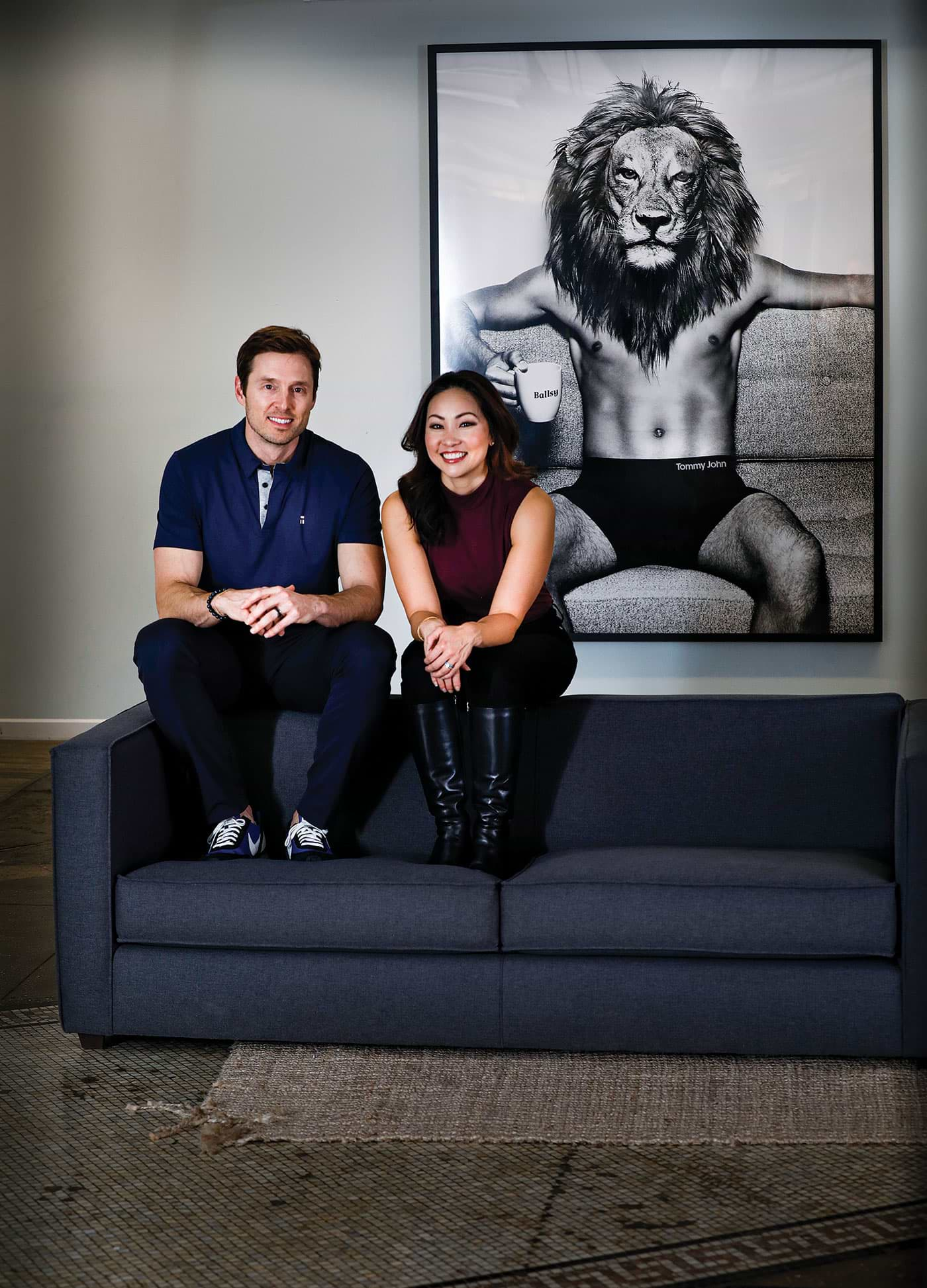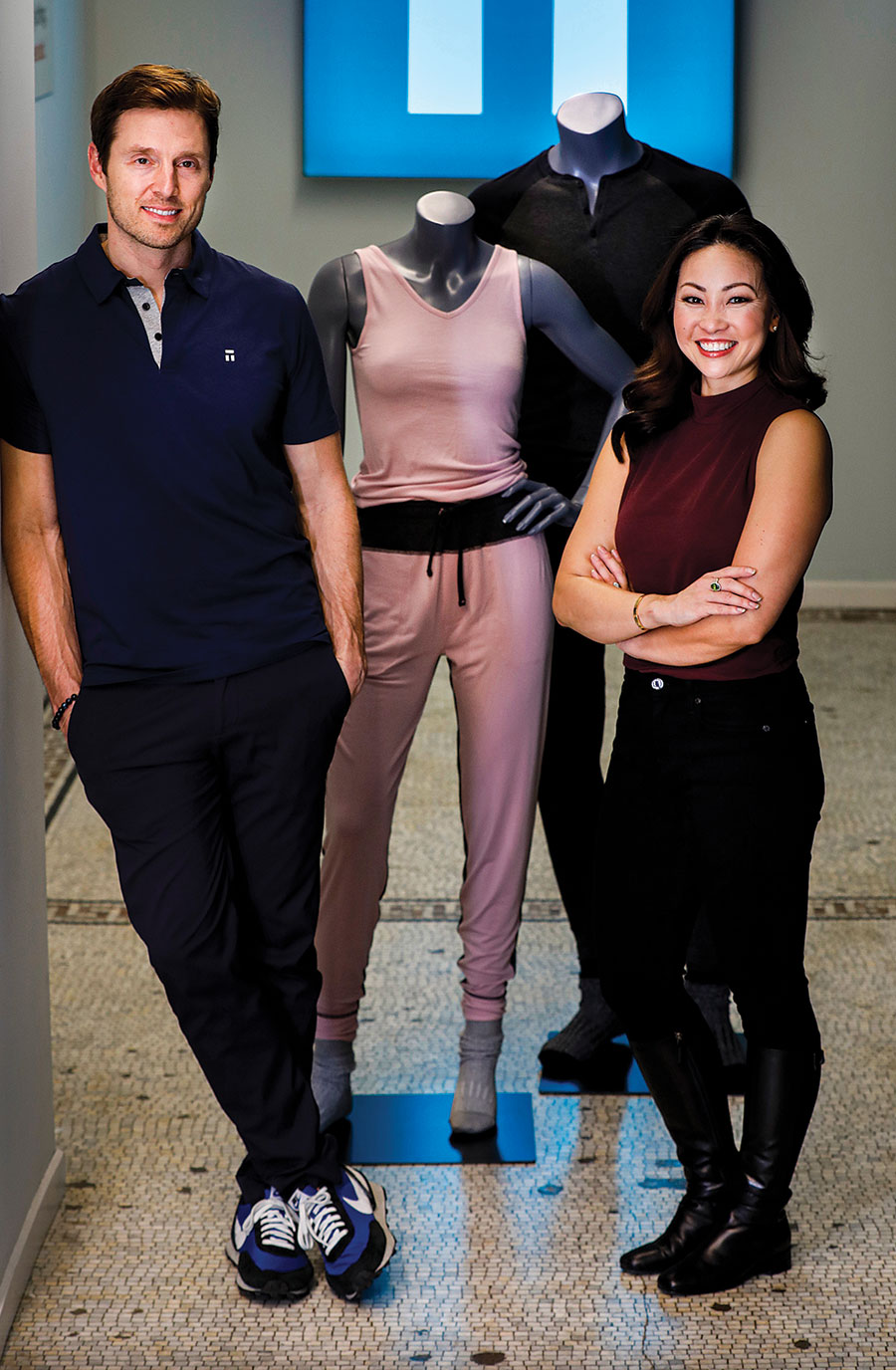— Tom Patterson
(BA Interdisciplinary Studies ’02)
— Erin Fujimoto
(BS Finance ’02)
alumni profile WPC
o adjustment needed.”
That’s the motto of cult favorite underwear company Tommy John, which was co-founded by ASU alumni Tom Patterson and Erin Fujimoto. Luckily, the duo didn’t apply that motto to their own lives: While Patterson was bothered by an undershirt that wouldn’t stay tucked in, Fujimoto had an itch to work at something she felt passionate about, and both made a few adjustments to create better lives for themselves.
After graduating from W. P. Carey in 2002 with a degree in interdisciplinary studies, Patterson took a job as a medical device salesman. “I wore undershirts, and I was tailoring my suits and shirts and I thought, ‘Why doesn’t anyone make an undershirt that’s not baggy and boxy and stays tucked in?’” That question sent him down a path of wanting to find a better way to make them. Growing up in South Dakota, he’d had an entrepreneurial spirit from the start, running lawn-mowing and snow-blowing businesses as a kid.
alumni profile WPC

— Tom Patterson
(BA Interdisciplinary Studies ’02)
— Erin Fujimoto
(BS Finance ’02)
o adjustment needed.”
That’s the motto of cult favorite underwear company Tommy John, which was co-founded by ASU alumni Tom Patterson and Erin Fujimoto. Luckily, the duo didn’t apply that motto to their own lives: While Patterson was bothered by an undershirt that wouldn’t stay tucked in, Fujimoto had an itch to work at something she felt passionate about, and both made a few adjustments to create better lives for themselves.
After graduating from W. P. Carey in 2002 with a degree in interdisciplinary studies, Patterson took a job as a medical device salesman. “I wore undershirts, and I was tailoring my suits and shirts and I thought, ‘Why doesn’t anyone make an undershirt that’s not baggy and boxy and stays tucked in?’” That question sent him down a path of wanting to find a better way to make them. Growing up in South Dakota, he’d had an entrepreneurial spirit from the start, running lawn-mowing and snow-blowing businesses as a kid.
Fujimoto, a Phoenix native who’d also graduated from ASU in 2002 with a degree in finance, was working at JPMorgan Chase bank and was about to start on a five-year path toward becoming a certified financial planner when the first course got canceled. Taking it as a serendipitous sign to rethink her career path, she evaluated her options: “I had the entrepreneurial bug, I had to wait another six months before I could enroll in the next series of classes, and I started thinking, ‘Do I want to be in finance?’”
She decided to jump ship and try her own thing. As a side project, she started an organic product website. “It was my first dabble in something entrepreneurial and I loved the entire process,” she says. Around that time, she met Patterson. Together, they’d watch a show called The Big Idea, about how entrepreneurs started their businesses.
“We would just riff on different business ideas and things we could do or make better,” Fujimoto remembers. “There was a passion for wanting to start something outside of our corporate America jobs.”
From couch to power couple
With their big ideas bubbling on the back burner in 2008, Patterson was laid off when the economy went into a tailspin. He’d read an article that a recession was the best time to start a business, and decided to go for it.
“I didn’t want to be this ‘coulda, shoulda, woulda’ guy 20 years from now, and I didn’t want to have any regrets,” he says. That perspective gave them the confidence to start the company, cash out their 401(k) savings, and put all their chips into the business.
“I think a lot of people are close, and they have this million-dollar idea,” he says. “But you have to get it into motion and start taking action. That’s tough because they’re scared and uncertain.”
Fujimoto and Patterson didn’t let fear stop them — or lack of knowledge or experience. They admit that they had no business starting a company, but say that may have been their secret weapon. “Our biggest advantage was that we didn’t know what we were doing, so we didn’t have any bias about how things should be done,” Patterson says.
The other key factor in their success was passion. “I solved a problem that was personal to me,” he says. “I think that’s what created the passion and authenticity we have in the business —we’re so closely tied to the product we sell.”
Plus, he adds, “I don’t like regretting things. I don’t want to have excuses in the back of my head. When we started the company, I said, ‘If I lose all my money — my 401(k), my savings — at the end of the day, I can always go back and get a medical sales job.’ I was good at it. I just wanted to check this off and see if I could do it.”
The company on the learning curve
Fujimoto and Patterson knew what they wanted to do but not exactly how to do it. They also knew they needed help, and they weren’t afraid to ask for it. That led them to one of two other men who’ve been instrumental in Tommy John’s success, fashion consultant Dana Fried.
Patterson met Fried at a fashion workshop in Orange County, California, a few months before the company launched in Neiman Marcus. During a break, he invited the consultant, who’d worked with many fashion and shoe brands, to lunch. “I wanted to talk with him and ask him questions,” Patterson says. “I felt like I needed to know someone who had that level of expertise.”
Fried turned down the invite, but their communication didn’t end there: At the end of the day, Patterson gave him a Tommy John undershirt and said, “Try it on and come back tomorrow and let me know if you like it. If you like it, you’ll find time to talk to me.” Fried’s feedback the next day was positive: “You have something special here. And I don’t say that to many people.”
Ten and a half years later, he’s still the company’s closest confidant. “There are so many pivotal moments in the business where we almost/maybe/could have lost the business, and he’s been that sounding board that’s helped us,” Patterson says. “We’ve broadened our network over the years, especially in New York. But he was a key person we met early on by putting ourselves out there.”
The second source of assistance came out of the blue: In 2013, Tommy John had an unexpectedly huge spike in traffic and sales. “We had no idea where it was coming from,” Fujimoto says, but soon a friend texted Patterson that he’d heard Howard Stern mention the company on his radio show. The shock jock ended up mentioning Tommy John a few more times and put the company out of stock. They ended up chasing inventory for about two years.
“It was the best and also the worst problem a new brand could have,” Fujimoto says. “We call it the ‘Howard Stern effect.’” After the initial mentions, the company went through five months of inventory in 45 days, but as CEO, Patterson was taking a beating on Twitter, where people were calling for him to be fired.
The upside — besides the great sales numbers — was that it gave the young company a crash course in supply chain. They implemented speed-to-market models and learned to partner better with their factories.
Making the most of mistakes
When the couple launched the company, friends and family questioned their choice. “They didn’t know what the heck we were doing, but we did,” Fujimoto says. “We had a vision and it continued to grow from there. This business has been taking it one step at a time for the past 12 years. That’s how we keep growing and scaling. As long as you can see that road ahead … that’s what we do next.”
That vision has always included trying new things and taking risks, because they weren’t afraid of screwing up every once in a while. “Mistakes have helped us take advantage of opportunities that came our way,” Patterson says. “And we wouldn’t have been able to see those opportunities if we hadn’t made some mistakes earlier. If you’re not trying to innovate and grow, you’re not making mistakes.”
The company encourages its 100-plus employees to think of new and different ways to do things, too. Tommy John’s five pillars of culture are: humble, adaptable, GSD (get s*** done), mindful, and curious. “Those are the attributes of our company and our employees,” Fujimoto says. “We always say if there’s a better way to do something, present it, create it, make it a reality. We’re all about doing it smarter and making things better, and continuing to evolve.”
Division of labor
On the job, Fujimoto and Patterson divide corporate duties, although at launch they did everything from answering phones to shipping orders to folding underwear into the packaging.

“Anything that can be done on a spreadsheet was my responsibility,” says Fujimoto. She handled finance and accounting, inventory forecasting, production, and operations. Patterson was more customer-facing in the stores, selling the product, training salespeople, and working on branding, marketing, and trademarking.
“In the early days, it was opposite skill sets, like yin and yang,” Patterson explains. “As the business has grown, we have become less generalists and more specialists.” Since the launch of the company’s women’s line in 2018, the pair overlaps more on the brand side and in design meetings and marketing-related things.
Off the clock, they share responsibilities of taking care of their two kids (ages 3 and 5) and themselves. “Our free time is very limited,” Fujimoto says, “but outside of Tommy John we try to spend as much time as a family as possible.”
Patterson echoes this priority. “Life now is different. It’s like ‘BK’ and ‘AK,’ right? Before kids and after kids. You have to pick and choose what you do with the time you have. Certain things are sacrificed if you want to spend time with your family.”
The couple also makes sure to focus on their fitness and wellness. A morning routine that includes working out and meditation helps ensure they’re prepared for what the day might throw at them. “There’s a lot that comes with this territory,” Fujimoto says. “Keeping our minds sharp to be able to lead this team and keep scaling the business is essential.”
Their nighttime routine is less structured but includes one essential rule: No talking about the bad things from work. “I like focusing on the good things,” she says. “If we try to talk about stresses or work through an issue at 9 in the evening, it’s not productive time or a good way to end the day.”
They also do what they can to take care of others. Tommy John supports the Testicular Cancer Foundation and the Honor Foundation, which is a career development program that places Navy SEALs into employment opportunities after their service and helps them transfer into civilian life.
Arizona adjustments
At the end of 2019, the family was heading back to Arizona; Tommy John recently opened a store at Scottsdale Fashion Square, the company’s third of four stand-alone retail spots.
Patterson, who used to sell cellphones at a kiosk at the mall during his ASU days, and Fujimoto, who hung out there in high school, are thrilled, both for themselves and the company. “There’s so much support from the community as a whole,” she says. “It’s been an exciting thing for me and Tom, but it’s been exciting for the rest of the company, too. There’s a certain energy that’s coming from that store.”
If those two teenagers could see themselves now, they’d likely have no regrets about the path that’s led them there.